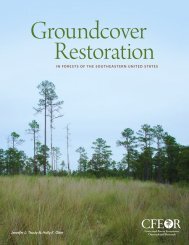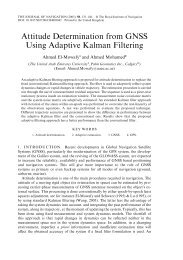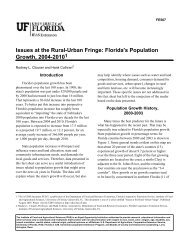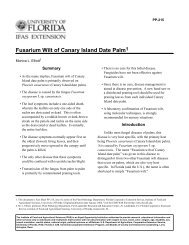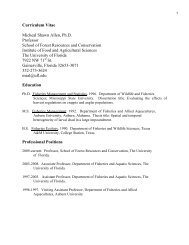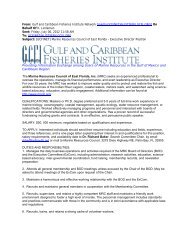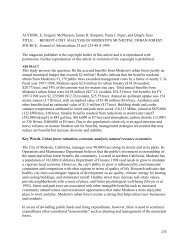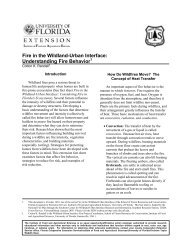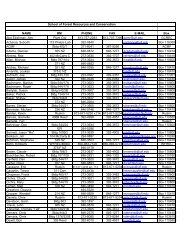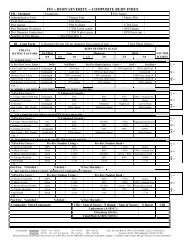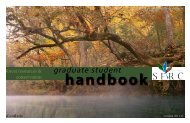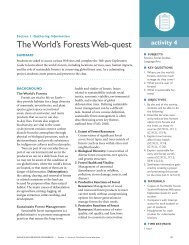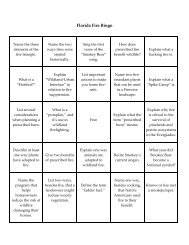Longleaf Pine Forest Restoration & Management - School of Forest ...
Longleaf Pine Forest Restoration & Management - School of Forest ...
Longleaf Pine Forest Restoration & Management - School of Forest ...
Create successful ePaper yourself
Turn your PDF publications into a flip-book with our unique Google optimized e-Paper software.
<strong>Longleaf</strong> <strong>Pine</strong> Regeneration 3<br />
The appropriate planting density will depend on<br />
your objectives. Low planting densities, 300 to 500<br />
seedlings per acre or less, may be appropriate for<br />
longleaf ecosystem restoration and/or to provide<br />
wildlife habitat (such as that for bobwhite quail),<br />
whereas 750 seedlings per acre or more may be<br />
desirable to optimize timber production and pine<br />
straw raking.<br />
Supplies <strong>of</strong> longleaf pine seedlings may not be<br />
sufficient to meet demands, so order your seedlings<br />
by early summer at the latest. For a list <strong>of</strong> longleaf<br />
nurseries, call your DOF County <strong>Forest</strong>er<br />
(http://www.fl-d<strong>of</strong>.com/field_operations/<br />
county_foresters/index.html) or the <strong>Longleaf</strong><br />
Alliance, at 334-427-1029, and request a copy <strong>of</strong> the<br />
<strong>Longleaf</strong> Nursery List. This is also available on their<br />
website: http://www.longleafalliance.org/.<br />
Choose a tree planting contractor that has<br />
experience with planting longleaf pine. Planting<br />
failures frequently result from improper seedling<br />
handling and planting. Hiring an experienced and<br />
reputable contractor may help to ensure seedling<br />
survival and minimize the possibility <strong>of</strong> having to<br />
replant.<br />
Bareroot Seedlings<br />
<strong>Longleaf</strong> pine seedlings at the nursery are<br />
stem-less and resemble a carrot with a clump <strong>of</strong> pine<br />
needles on top. Ideally, bareroot seedlings should<br />
have: (1) a root collar diameter (RCD) <strong>of</strong> 0.4 to 0.6<br />
inch; (2) a stout, 6- to 8-inch or longer tap root; (3) at<br />
least 6 well-developed, 6- to 8-inch lateral roots with<br />
evidence <strong>of</strong> ectomycorrhizal development; (4) a<br />
winter bud with scales; (5) abundant, large, fascicled<br />
needles that are free <strong>of</strong> brown-spot disease; (6) been<br />
grown at a reputable nursery; (7) been undercut in the<br />
nursery bed well before lifting; and (8) a seed source<br />
from the same region as the planting site. Seedlings<br />
with a RCD <strong>of</strong> 0.3 inch or less generally have low<br />
survival rates.<br />
<strong>Longleaf</strong> seedlings come out <strong>of</strong> the grass stage<br />
and initiate stem height growth when the seedlings<br />
have a RCD <strong>of</strong> about one inch. After planting,<br />
longleaf seedlings allocate their growth to develop a<br />
tap root prior to initiating stem height growth. As<br />
noted above, seedlings may initiate height growth at a<br />
younger age if competing vegetation is controlled.<br />
Once the seedlings emerge from the grass stage,<br />
height growth is comparable with loblolly or slash<br />
pine <strong>of</strong> the same age.<br />
Containerized Seedlings<br />
There is increasing interest in using<br />
containerized longleaf pine seedlings (plugs) because<br />
they generally have greater survival than bareroot<br />
seedlings. Also, containerized seedlings can be<br />
planted throughout the year, whenever soil moisture<br />
is adequate before and after planting. Containerized<br />
seedlings have even been successfully planted during<br />
the hot summer months, when afternoon rains are<br />
common. They can be used to replant partial<br />
regeneration failures in the year they occur as well.<br />
Studies have shown that both fall-planted and late<br />
winter-planted containerized longleaf seedlings <strong>of</strong>ten<br />
have better survival and growth than winter-planted<br />
bareroot seedlings. Seedlings grown in large<br />
containers (large plugs) can enhance survival on<br />
adverse sites, but to ensure success sufficient site<br />
preparation and vegetation control measures must be<br />
taken.<br />
The main drawback <strong>of</strong> containerized seedlings is<br />
cost. On average, the price per thousand is about<br />
twice as much for container-grown seedlings as the<br />
cost for bareroot seedlings. The larger the plug<br />
volume, the greater the cost to produce the plugs.<br />
Also, containerized seedlings are more bulky to<br />
handle during shipping and planting. However,<br />
cost-share programs and increased survival make<br />
them a feasible option.<br />
Nursery to Field<br />
Proper care and handling <strong>of</strong> seedlings from the<br />
nursery to the field includes several steps: (1) pick up<br />
seedlings from the nursery the day they are lifted; (2)<br />
protect roots from desiccation; (3) protect seedlings<br />
from wind and refrigerate them if possible during<br />
transportation to the planting site (place plugs loosely<br />
in large coolers or waxed boxes); (4) store seedlings<br />
in a cool, well-ventilated area for no more than three<br />
days before planting (or up to 3 weeks in<br />
refrigeration, 5 weeks with humidity control); and<br />
(5) do not expose seedlings to sunlight or heat. To



